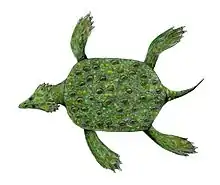Lagenanectes
Lagenanectes is a genus of elasmosaurid plesiosaur from the Lower Cretaceous, found in Lower Saxony, Germany. The only species, Lagenanectes richterae, was first described in 2017, and is regarded as one of the best-preserved plesiosaur fossils from this geological age in Europe.[1] Lagenanectes is one of the earliest elasmosaurids. The holotype is an incomplete skeleton, comprising large parts of the skull, some neck and tail vertebrae as well as ribs and part of the limbs. A length of about 8 meters (26 feet) has been estimated.[1]
| Lagenanectes Temporal range: | |
|---|---|
 | |
| Lagenanectes richterae, skull reconstruction in right lateral view | |
| Scientific classification | |
| Domain: | Eukaryota |
| Kingdom: | Animalia |
| Phylum: | Chordata |
| Class: | Reptilia |
| Superorder: | †Sauropterygia |
| Order: | †Plesiosauria |
| Family: | †Elasmosauridae |
| Genus: | †Lagenanectes |
| Species: | †L. richterae |
| Binomial name | |
| †Lagenanectes richterae Sachs, Hornung & Kear, 2017 | |
Discovery and naming

The well-preserved holotype specimen of Lagenanectes richterae (specimen number BGR Ma 13328) was found in the disused Moorberg clay pit near Sarstedt by private collectors in 1964.[2] The exact horizon is unknown (the age of the fossils might be lower Hauterivian to lower Barremian, but most probably is upper Hauterivian). The fossils were later given to the Geological Survey at Hannover, where Professor Sickenberg identified them as elasmosaurid remains.[2] They have subsequently been transferred to the Lower Saxony State Museum in Hannover, where part of the specimen is now on display.[3] However, it was not until some 50 years later, in 2017, that Sven Sachs, Jahn J. Hornung and Benjamin P. Kear studied the fossil in detail and erected Lagenanectes as a new, monotypic genus.[4]
The name Lagenanectes literally means "Leine swimmer" and refers to both, the Leine river which passes Sarstedt, and to the swimming life style of this marine reptile. The species name richterae honours Annette Richter, chief curator of the Natural History department at the Lower Saxony State Museum in Hannover, for her contributions to the palaeontological exploration of Lower Saxony.
Description
The holotype of Lagenanectes richterae was a fully grown individual. This is indicated by the ossification of both the cranial bones and the vertebrae and neural arches.[1]
The front part of the lower jaw of Lagenanectes richterae shows some anatomical features which are unique in plesiosaurs (autapomorphies): The alveols are placed sidewards and a platform is present on the underside of the lower jaw that bears prominent dents. The skull of Lagenanectes shows a rounded snout that is accompanied by some grooves on the upper side. These grooves may have accommodated electroreceptors to locate the prey. The neck vertebrae of Lagenanectes are square-shaped and lack a notch on the lower side of the articular surfaces of the vertebral centra, which is characteristic for other elasmosaurs.[5]
Classification

The study by Sachs and colleagues demonstrated that Lagenanectes richterae was an early member of the elasmosaurids. Following their cladistic analysis, Lagenanectes was most closely related to the "Speeton Clay plesiosaur" (a yet undescribed plesiosaur from the Hauterivian of England, and to Callawayasaurus from the Aptian of Colombia.[1]
Pathologies
The occiput and the first neck vertebra of the holotype of Lagenanectes richterae show pathological alterations of the bony structure. They may have been caused by an infection.[1][6]
Gallery
 Skull of Lagenanectes seen from above
Skull of Lagenanectes seen from above Lower jaw of Lagenanectes richterae in side view
Lower jaw of Lagenanectes richterae in side view Tooth of Lagenanectes richterae
Tooth of Lagenanectes richterae Neck vertebra of Lagenanectes richterae in side view
Neck vertebra of Lagenanectes richterae in side view
References
- Sven Sachs; Jahn J. Hornung; Benjamin P. Kear (2017). "A new basal elasmosaurid (Sauropterygia: Plesiosauria) from the Lower Cretaceous of Germany". Journal of Vertebrate Paleontology. 37 (4): e1301945. doi:10.1080/02724634.2017.1301945. S2CID 134707537.
- Erika Finzel (1964). "Plesiosaurusfund in der Unterkreide". Der Aufschluss. 11: 301.
- "Neue Saurierart im Landesmuseum entdeckt". haz.de. Archived from the original on 2017-11-10. Retrieved 2017-11-10.
- "Meet Lagenanectes richterae, One of Oldest Known Elasmosaurs | Paleontology | Sci-News.com". Breaking Science News | Sci-News.com. Retrieved 2017-09-15.
- S. Sachs; B. P. Kear (2015). "Fossil Focus: Elasmosaurs". Palaeontology Online. 5: 1–8.
- Sven Sachs; Jahn J. Hornung; Peter Wohlsein; Benjamin P. Kear (2015). "A new basal elasmosaurid skeleton with joint pathologies from the Lower Cretaceous of Germany". 13th Annual Meeting of the European Association of Vertebrate Palaeontologists, Opole, Poland, 8–12 July 2015. Abstracts: 131.
External links
- Lagenanectes richterae. Sachs Vertebrate Palaeontology Research.






.png.webp)